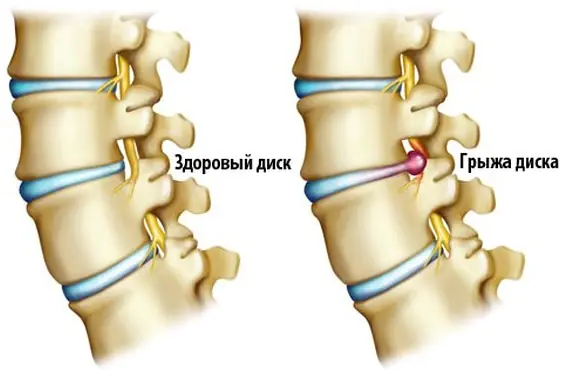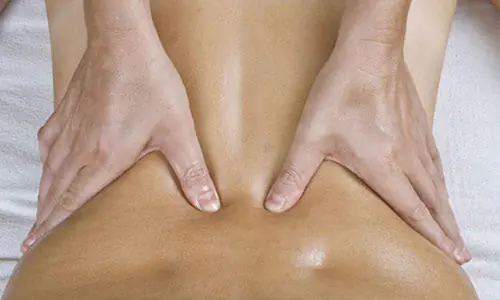Spinal diseases have a detrimental effect on the health of the entire body. The negative impact can affect the circulatory and nervous systems, as well as the condition of internal organs. Intervertebral hernia is one of the most serious diseases of the spine. In most cases, this disease is treated surgically. But massage for a spinal hernia is a good alternative to surgery.
A properly performed massage procedure will eliminate pain, improve blood circulation and tissue nutrition. Massage is also prescribed for preventive purposes, to speed up the recovery process. The risk of the disease becoming chronic is significantly reduced.

Massage for intervertebral hernia
Of course, treating hernia formations in this area is a very serious and responsible matter, which only specialists can handle. The treatment process, depending on the degree of the disease, can be divided into three main stages:
- conservative treatment, which is aimed at treatment without surgery;
- surgical method of treatment;
- postoperative recovery method.
As for conservative treatment, the chance of success will depend on the extent of the disease and its location. The main thing in this matter is to minimize the period of exacerbation and achieve a positive result for a longer period.
Conservative treatment has several significant advantages over surgical treatment:
- The treatment can be performed on both an infant and an elderly person.
- Due to gentle non-traumatic pressure, the pain threshold in the affected area can be reduced as much as possible.
We invite you to familiarize yourself with the main conservative manipulations of non-surgical intervention:
- massage;
- treatment under the supervision of a specialist;
- treatment in sanatorium-resort conditions;
- reflexology, acupuncture;
- treatment with exercise;
- yoga.

Man experiencing back pain
Features of massage for intervertebral hernia
In some cases, massage of the spine can negatively affect its stability, especially in areas with hernial formations.
Therefore, it is prohibited to perform massage in the first days of exacerbation of the disease.
In 7 out of 10 cases, the formation of an intervertebral hernia is accompanied by displacement of the intervertebral joints. It is in these cases that the effectiveness of massage increases several times.
It is worth noting that massage for hernia formations should only be performed by an experienced and qualified specialist. Only a professional can achieve positive results in treatment and avoid possible disastrous consequences.
This procedure has many of its own features and subtleties. The massage technique should be carried out with special care and attention to the patient. The patient should not feel pain. All elements, especially power ones, must be carried out gently. If the patient feels pain, the procedure should be postponed for some time.
If the movements are too sudden and forceful, this can lead to further and more severe rupture of the intervertebral discs. In this case, the spasms will intensify, the swelling of the damaged tissues will increase. Surgery will eventually be required.
What types of massage can be used:
- general (classical) massage;
- can;
- segmental;
- point;
- Thai;
- honey;
- therapeutic massage of the entire spine.
Contraindications:
- increased pain syndrome;
- skin diseases;
- oncological diseases;
- pregnancy;
- diseases of internal organs;
- high body temperature.
Technique
Let us consider in more detail the technique of performing various types of massage.
General massage
During a general massage, the patient is positioned in a position that is comfortable for him (sitting, lying down). The specialist begins the procedure with stroking and rubbing.
Next, the massage therapist finds the location of the pain and performs acupressure massage in these areas. Typically three points are used. The techniques are performed with the second and third fingers using slow rotational movements.
During the massage, the fingers should not leave the spine. The pressure increases. This massage technique is repeated 4 times, after which the fingers return to their original position.

Kneading pain points
Cupping massage
This procedure combines the effects of massage and physiotherapy. How the procedure works: rarefied air is created inside the jar, which affects the peripheral blood circulation. Ultimately, congestion is eliminated, pain is minimized, and toxins and toxic substances are removed from the body. Also influenced are biologically active points, which have a local reflex effect.
The vacuum is created using ordinary plastic pneumatic jars, or using glass medical ones.
Features:
- the vacuum should suck the skin to a height of at least 1-2 cm;
- To ensure that the jar glides easily over the skin, massage oil is used;
- After a vacuum massage, bruises may form on the massaged area, which will disappear in a couple of days.
All movements are made along the blood and lymphatic vessels, from bottom to top. The masseur performs smooth straight, zigzag, spiral continuous slides. The procedure lasts 5-15 minutes.

Massage therapist installing glass massage jars
Honey massage
Bee products are in most cases prescribed when effective stimulation of nerve endings is necessary. Therefore, honey massage for intervertebral hernia is a powerful auxiliary effect. Skin receptors are irritated, skin nutrition occurs.
I would like to note the important effect of honey massage - the procedure fights the hernial formation itself, as if drawing out toxins and toxic substances from the body.
The procedure with honey is very useful for a weakened body. Elderly people also benefit from this therapy. But for children, the procedure should be performed with extreme caution. In this case, use a mixture of honey and fir oil.
First, the inflamed area is warmed up with stroking movements. Then a thin layer of honey is applied to the skin. Next, the massage therapist performs patting movements. The palms begin to stick to the skin, and slight pain appears. At the end of the procedure, a warming gel is applied to the sore spot, the patient is wrapped in a blanket and rests.
Treatment of intervertebral hernia takes quite a long time. Therefore, you should be patient and follow unquestioningly all the recommendations of your doctor. To avoid further development of the disease, you must adhere to the following recommendations:
- lead a healthy lifestyle;
- do physical therapy for the spine;
- Healthy food;
- control your weight.
Massage in this case is the most optimal element in the treatment of this disease.



